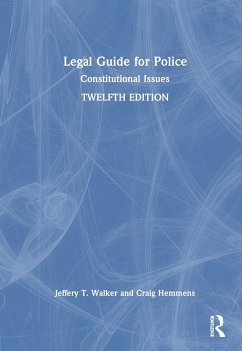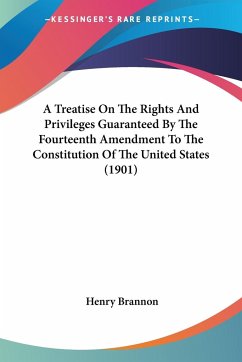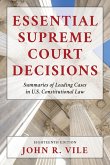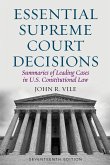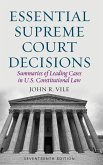- Gebundenes Buch
- Merkliste
- Auf die Merkliste
- Bewerten Bewerten
- Teilen
- Produkt teilen
- Produkterinnerung
- Produkterinnerung
Legal Guide for Police: Constitutional Issues, 12th Edition, is a valuable tool for criminal justice students and law enforcement professionals, bringing them up-to-date with developments in the law of arrest, search and seizure, police authority to detain, questioning suspects and pretrial identification procedures, police power and its limitations, and civil liability of police officers and agencies. Including specific case examples, this revised edition provides the most current information for students and law enforcement professionals needing to develop an up-to-date understanding of the…mehr
Andere Kunden interessierten sich auch für
![A Treatise On The Rights And Privileges Guaranteed By The Fourteenth Amendment To The Constitution Of The United States (1901) A Treatise On The Rights And Privileges Guaranteed By The Fourteenth Amendment To The Constitution Of The United States (1901)]() Henry BrannonA Treatise On The Rights And Privileges Guaranteed By The Fourteenth Amendment To The Constitution Of The United States (1901)46,99 €
Henry BrannonA Treatise On The Rights And Privileges Guaranteed By The Fourteenth Amendment To The Constitution Of The United States (1901)46,99 €![Essential Supreme Court Decisions Essential Supreme Court Decisions]() John R. VileEssential Supreme Court Decisions51,99 €
John R. VileEssential Supreme Court Decisions51,99 €![The Federalist Papers, Including the Constitution of the United States The Federalist Papers, Including the Constitution of the United States]() Alexander HamiltonThe Federalist Papers, Including the Constitution of the United States26,99 €
Alexander HamiltonThe Federalist Papers, Including the Constitution of the United States26,99 €![Essential Supreme Court Decisions Essential Supreme Court Decisions]() John R. VileEssential Supreme Court Decisions54,99 €
John R. VileEssential Supreme Court Decisions54,99 €![Essential Supreme Court Decisions Essential Supreme Court Decisions]() John R. VileEssential Supreme Court Decisions133,99 €
John R. VileEssential Supreme Court Decisions133,99 €![Guardian of the Wall Guardian of the Wall]() J. David HolcombGuardian of the Wall131,99 €
J. David HolcombGuardian of the Wall131,99 €![Degraded Caste of Society Degraded Caste of Society]() Andrew T FedeDegraded Caste of Society51,99 €
Andrew T FedeDegraded Caste of Society51,99 €-
-
-
Legal Guide for Police: Constitutional Issues, 12th Edition, is a valuable tool for criminal justice students and law enforcement professionals, bringing them up-to-date with developments in the law of arrest, search and seizure, police authority to detain, questioning suspects and pretrial identification procedures, police power and its limitations, and civil liability of police officers and agencies. Including specific case examples, this revised edition provides the most current information for students and law enforcement professionals needing to develop an up-to-date understanding of the law. Authors Walker and Hemmens have included introductory and summary chapters to aid readers in understanding the context, importance, and applicability of the case law. All chapters have been updated to reflect U.S. Supreme Court decisions up to and including the 2021 term of court. Important cases added to this edition include: Caniglia v. Strom (2021) (warrantless search), Kansas v. Glover (2020) (vehicle stop), Mitchell v. Wisconsin (2019) (warrantless drawing of blood), Rivas-Villegas v. Cortesluna (qualified immunity), and Nieves v. Bartlett (2018) (retaliatory arrest). A helpful Appendix contains the Bill of Rights and the Fourteenth Amendment, and a Table of Cases lists every case referenced in the text.
Hinweis: Dieser Artikel kann nur an eine deutsche Lieferadresse ausgeliefert werden.
Hinweis: Dieser Artikel kann nur an eine deutsche Lieferadresse ausgeliefert werden.
Produktdetails
- Produktdetails
- Verlag: Routledge
- 12. Auflage
- Seitenzahl: 292
- Erscheinungstermin: 28. Juni 2023
- Englisch
- Abmessung: 260mm x 183mm x 20mm
- Gewicht: 748g
- ISBN-13: 9781032376288
- ISBN-10: 1032376287
- Artikelnr.: 67516006
- Herstellerkennzeichnung
- Libri GmbH
- Europaallee 1
- 36244 Bad Hersfeld
- gpsr@libri.de
- Verlag: Routledge
- 12. Auflage
- Seitenzahl: 292
- Erscheinungstermin: 28. Juni 2023
- Englisch
- Abmessung: 260mm x 183mm x 20mm
- Gewicht: 748g
- ISBN-13: 9781032376288
- ISBN-10: 1032376287
- Artikelnr.: 67516006
- Herstellerkennzeichnung
- Libri GmbH
- Europaallee 1
- 36244 Bad Hersfeld
- gpsr@libri.de
Jeffery T. Walker is an endowed chair in the J. Frank Barefield Jr. Department of Criminal Justice at the University of Alabama, Birmingham. Dr. Walker has written ten books and almost 100 journal articles and book chapters. He has obtained over $20 million in grants from the Department of Justice, National Institute of Drug Abuse, National Science Foundation, and others. His areas of interest are social/environmental factors of neighborhoods, legal issues of policing, and crime mapping/crime analysis. He is a past President of the Academy of Criminal Justice Sciences. Editorial experience includes service as Editor of the Journal of Criminal Justice Education. Previous publications include articles in Justice Quarterly, Journal of Quantitative Criminology, and Journal of Criminal Justice Education, and the books Leading Cases in Law Enforcement (10th Edition) and Foundations of Crime Analysis. Dr. Walker also served as a Special Agent with the Air Force Office of Special Investigations (AFOSI), conducting major felony crime investigations. In September 2001, Dr. Walker was mobilized to provide counterintelligence, protective services, and force protection support to military personnel in U.S. and overseas locations. His final assignment was Superintendent of Counter-intelligence Investigations at Headquarters/AFOSI in Washington, D.C. Craig Hemmens is a Professor in the Department of Criminal Justice and Criminology at Washington State University. He has previously served as Chair of the Department of Criminology and Criminal Justice at Washington State University, at the Department of Criminology and Criminal Justice at Missouri State University, and at the Department of Criminal Justice at Boise State University. He is a past President of the Academy of Criminal Justice Sciences. Professor Hemmens has published more than 20 books and 200 articles on a variety of criminal justice-related topics. He holds a J.D. from North Carolina Central University School of Law and a Ph.D. in Criminal Justice from Sam Houston State University. In 2016 he was awarded the Academy of Criminal Justice Sciences (ACJS) prestigious Founder's Award for outstanding contributions to criminal justice education and ACJS.
Preface
CHAPTER 1. Introduction
§ 1.1 Criminal Procedure
§ 1.2 Sources of Criminal Procedure Law
§ 1.3 Judicial Functions
§ 1.4 The Supreme Court and the Police
§ 1.5 Packer's Models of the Criminal Justice System
§ 1.6 Summary
CHAPTER 2. Results of Failure to Comply with Constitutional Mandates
§ 2.1 The Exclusionary Rule
§ 2.2 Extension of the Exclusionary Rule to All Courts: Mapp v. Ohio
§ 2.3 Application and Modification of the Exclusionary Rule
§ 2.4 Civil Liabilities
§ 2.5 Civil Rights Actions
§ 2.6 Liability of Supervisors, Administrators, and Agencies
§ 2.7 Admissibility of Evidence
§ 2.8 Summary
CHAPTER 3. Police Power and Limitations
§ 3.1 Police Power, Authority, and Responsibility
§ 3.2 Limits on Police Authority
§ 3.3 Bill of Rights
§ 3.4 Due Process of Law
§ 3.5 Effects of Broadening the Scope of the Fourteenth Amendment Due
Process Clause
§ 3.6 Protection of Rights via State Constitutions and Laws
§ 3.7 Summary
CHAPTER 4. Police Authority to Detain
§ 4.1 General Considerations
§ 4.2 Consensual Encounters
§ 4.3 Terry v. Ohio Stop-and-Frisk Rationale
§ 4.4 Application to Off-Street Situations
§ 4.5 Application to Detention of Motorists
§ 4.6 Detention of Luggage
§ 4.7 Duration of the Detention
§ 4.8 Detention to Check Driver's License and Registration
§ 4.9 Detention at Police Roadblocks
§ 4.10 Summary
CHAPTER 5. Law of Arrest
§ 5.1 General Considerations
§ 5.2 Statutory Authority to Arrest
§ 5.3 Definition and Elements of Arrest
§ 5.4 Arrest under the Authority of an Arrest Warrant
§ 5.5 Arrest without a Warrant
§ 5.6 Post-Arrest Probable Cause Determination
§ 5.7 Use of Force in Making an Arrest
§ 5.8 The Citation and Summons in Law Enforcement
§ 5.9 Arrest after Fresh Pursuit
§ 5.10 Summary
CHAPTER 6. Search and Seizure with a Warrant
§ 6.1 General Considerations
§ 6.2 Constitutional Provisions
§ 6.3 Seizure with a Valid Search Warrant-General
§ 6.4 The Warrant Must Be Issued on Probable Cause
§ 6.5 A Proper Official Must Issue the Warrant
§ 6.6 The Warrant Must Be Supported by Oath or Affirmation
§ 6.7 The Place to Be Searched and the Things to Be Seized Must Be
Particularly Described
§ 6.8 Execution of the Search Warrant
§ 6.9 Search of a Person on the Premises
§ 6.10 Return of the Warrant
§ 6.11 Summary
CHAPTER 7. Search and Seizure without a Warrant
§ 7.1 General Considerations
§ 7.2 Search Incident to a Lawful Arrest
§ 7.3 Search with a Valid Waiver (Consent Searches)
§ 7.4 Exigent Circumstances Exception to the Warrant Requirement
§ 7.5 Plain View Searches
§ 7.6 Search of Premises Not Protected by the Fourth Amendment (Open
Fields)
§ 7.7 Search by a Private Individual
§ 7.8 Standing to Challenge the Search
§ 7.9 Stop-and-Frisk
§ 7.10 Airport Searches
§ 7.11 Search of Pervasively Regulated Businesses
§ 7.12 Summary
CHAPTER 8. Specialized Searches without a Warrant: Vehicles, Dogs, and
Technology
§ 8.1 General Considerations
§ 8.2 Search of Movable Vehicles and Objects
§ 8.3 Searches Related to Driving While Intoxicated Cases
§ 8.4 Search after Lawful Impoundment (Inventory Searches)
§ 8.5 Use of Dogs in Searches
§ 8.6 6 Electronic Searches and Seizure of Verbal Evidence via Recorders or
Microphones
§ 8.7 Other Searches Using Technology
§ 8.8 Cell Phones and Computers
§ 8.9 Summary
CHAPTER 9. Questioning Suspects
§ 9.1 General Considerations
§ 9.2 The Free and Voluntary Rule
§ 9.3 Warning and Waiver Requirements (Miranda Rule)
§ 9.4 Exclusion Related to the Fourth Amendment
§ 9.5 Right to Counsel
§ 9.6 The Delay in Arraignment Rule
§ 9.7 Exceptions to Right to Counsel and Self-Incrimination
§ 9.8 Admissibility of a Second Confession After an Inadmissible First
Confession
§ 9.9 Summary
CHAPTER 10. Pretrial Identification Procedures
§ 10.1 General Considerations
§ 10.2 Fingerprinting and Photographing Suspects
§ 10.3 Lineup-Self-Incrimination Challenge
§ 10.4 Lineup-Right to Counsel Challenge
§ 10.5 Lineup-Due Process Challenge
§ 10.6 Pretrial Photographic Identification
§ 10.7 Dental Examination
§ 10.8 Voice Exemplars
§ 10.9 Footprint Comparisons and Other Body Examinations
§ 10.10 Deoxyribonucleic Acid (DNA) Tests
§ 10.11 Summary
CHAPTER 11. Police Law in Practice
§ 11.1 General Considerations
§ 11.2 The Consequences of Not Complying with the Law
§ 11.3 Detention and Arrest
§ 11.4 Searches and Seizures
§ 11.5 Questioning Suspects
§ 11.6 Pretrial Identification
§ 11.7 When You Are On Your Own
Appendix
The Bill of Rights (First Ten Amendments to the Constitution) and the
Fourteenth Amendment
Table of Cases
Index
CHAPTER 1. Introduction
§ 1.1 Criminal Procedure
§ 1.2 Sources of Criminal Procedure Law
§ 1.3 Judicial Functions
§ 1.4 The Supreme Court and the Police
§ 1.5 Packer's Models of the Criminal Justice System
§ 1.6 Summary
CHAPTER 2. Results of Failure to Comply with Constitutional Mandates
§ 2.1 The Exclusionary Rule
§ 2.2 Extension of the Exclusionary Rule to All Courts: Mapp v. Ohio
§ 2.3 Application and Modification of the Exclusionary Rule
§ 2.4 Civil Liabilities
§ 2.5 Civil Rights Actions
§ 2.6 Liability of Supervisors, Administrators, and Agencies
§ 2.7 Admissibility of Evidence
§ 2.8 Summary
CHAPTER 3. Police Power and Limitations
§ 3.1 Police Power, Authority, and Responsibility
§ 3.2 Limits on Police Authority
§ 3.3 Bill of Rights
§ 3.4 Due Process of Law
§ 3.5 Effects of Broadening the Scope of the Fourteenth Amendment Due
Process Clause
§ 3.6 Protection of Rights via State Constitutions and Laws
§ 3.7 Summary
CHAPTER 4. Police Authority to Detain
§ 4.1 General Considerations
§ 4.2 Consensual Encounters
§ 4.3 Terry v. Ohio Stop-and-Frisk Rationale
§ 4.4 Application to Off-Street Situations
§ 4.5 Application to Detention of Motorists
§ 4.6 Detention of Luggage
§ 4.7 Duration of the Detention
§ 4.8 Detention to Check Driver's License and Registration
§ 4.9 Detention at Police Roadblocks
§ 4.10 Summary
CHAPTER 5. Law of Arrest
§ 5.1 General Considerations
§ 5.2 Statutory Authority to Arrest
§ 5.3 Definition and Elements of Arrest
§ 5.4 Arrest under the Authority of an Arrest Warrant
§ 5.5 Arrest without a Warrant
§ 5.6 Post-Arrest Probable Cause Determination
§ 5.7 Use of Force in Making an Arrest
§ 5.8 The Citation and Summons in Law Enforcement
§ 5.9 Arrest after Fresh Pursuit
§ 5.10 Summary
CHAPTER 6. Search and Seizure with a Warrant
§ 6.1 General Considerations
§ 6.2 Constitutional Provisions
§ 6.3 Seizure with a Valid Search Warrant-General
§ 6.4 The Warrant Must Be Issued on Probable Cause
§ 6.5 A Proper Official Must Issue the Warrant
§ 6.6 The Warrant Must Be Supported by Oath or Affirmation
§ 6.7 The Place to Be Searched and the Things to Be Seized Must Be
Particularly Described
§ 6.8 Execution of the Search Warrant
§ 6.9 Search of a Person on the Premises
§ 6.10 Return of the Warrant
§ 6.11 Summary
CHAPTER 7. Search and Seizure without a Warrant
§ 7.1 General Considerations
§ 7.2 Search Incident to a Lawful Arrest
§ 7.3 Search with a Valid Waiver (Consent Searches)
§ 7.4 Exigent Circumstances Exception to the Warrant Requirement
§ 7.5 Plain View Searches
§ 7.6 Search of Premises Not Protected by the Fourth Amendment (Open
Fields)
§ 7.7 Search by a Private Individual
§ 7.8 Standing to Challenge the Search
§ 7.9 Stop-and-Frisk
§ 7.10 Airport Searches
§ 7.11 Search of Pervasively Regulated Businesses
§ 7.12 Summary
CHAPTER 8. Specialized Searches without a Warrant: Vehicles, Dogs, and
Technology
§ 8.1 General Considerations
§ 8.2 Search of Movable Vehicles and Objects
§ 8.3 Searches Related to Driving While Intoxicated Cases
§ 8.4 Search after Lawful Impoundment (Inventory Searches)
§ 8.5 Use of Dogs in Searches
§ 8.6 6 Electronic Searches and Seizure of Verbal Evidence via Recorders or
Microphones
§ 8.7 Other Searches Using Technology
§ 8.8 Cell Phones and Computers
§ 8.9 Summary
CHAPTER 9. Questioning Suspects
§ 9.1 General Considerations
§ 9.2 The Free and Voluntary Rule
§ 9.3 Warning and Waiver Requirements (Miranda Rule)
§ 9.4 Exclusion Related to the Fourth Amendment
§ 9.5 Right to Counsel
§ 9.6 The Delay in Arraignment Rule
§ 9.7 Exceptions to Right to Counsel and Self-Incrimination
§ 9.8 Admissibility of a Second Confession After an Inadmissible First
Confession
§ 9.9 Summary
CHAPTER 10. Pretrial Identification Procedures
§ 10.1 General Considerations
§ 10.2 Fingerprinting and Photographing Suspects
§ 10.3 Lineup-Self-Incrimination Challenge
§ 10.4 Lineup-Right to Counsel Challenge
§ 10.5 Lineup-Due Process Challenge
§ 10.6 Pretrial Photographic Identification
§ 10.7 Dental Examination
§ 10.8 Voice Exemplars
§ 10.9 Footprint Comparisons and Other Body Examinations
§ 10.10 Deoxyribonucleic Acid (DNA) Tests
§ 10.11 Summary
CHAPTER 11. Police Law in Practice
§ 11.1 General Considerations
§ 11.2 The Consequences of Not Complying with the Law
§ 11.3 Detention and Arrest
§ 11.4 Searches and Seizures
§ 11.5 Questioning Suspects
§ 11.6 Pretrial Identification
§ 11.7 When You Are On Your Own
Appendix
The Bill of Rights (First Ten Amendments to the Constitution) and the
Fourteenth Amendment
Table of Cases
Index
Preface
CHAPTER 1. Introduction
1.1 Criminal Procedure
1.2 Sources of Criminal Procedure Law
1.3 Judicial Functions
1.4 The Supreme Court and the Police
1.5 Packer's Models of the Criminal Justice System
1.6 Summary
CHAPTER 2. Results of Failure to Comply with Constitutional Mandates
2.1 The Exclusionary Rule
2.2 Extension of the Exclusionary Rule to All Courts: Mapp v. Ohio
2.3 Application and Modification of the Exclusionary Rule
2.4 Civil Liabilities
2.5 Civil Rights Actions
2.6 Liability of Supervisors, Administrators, and Agencies
2.7 Admissibility of Evidence
2.8 Summary
CHAPTER 3. Police Power and Limitations
3.1 Police Power, Authority, and Responsibility
3.2 Limits on Police Authority
3.3 Bill of Rights
3.4 Due Process of Law
3.5 Effects of Broadening the Scope of the Fourteenth Amendment Due Process Clause
3.6 Protection of Rights via State Constitutions and Laws
3.7 Summary
CHAPTER 4. Police Authority to Detain
4.1 General Considerations
4.2 Consensual Encounters
4.3 Terry v. Ohio Stop-and-Frisk Rationale
4.4 Application to Off-Street Situations
4.5 Application to Detention of Motorists
4.6 Detention of Luggage
4.7 Duration of the Detention
4.8 Detention to Check Driver's License and Registration
4.9 Detention at Police Roadblocks
4.10 Summary
CHAPTER 5. Law of Arrest
5.1 General Considerations
5.2 Statutory Authority to Arrest
5.3 Definition and Elements of Arrest
5.4 Arrest under the Authority of an Arrest Warrant
5.5 Arrest without a Warrant
5.6 Post-Arrest Probable Cause Determination
5.7 Use of Force in Making an Arrest
5.8 The Citation and Summons in Law Enforcement
5.9 Arrest after Fresh Pursuit
5.10 Summary
CHAPTER 6. Search and Seizure with a Warrant
6.1 General Considerations
6.2 Constitutional Provisions
6.3 Seizure with a Valid Search Warrant-General
6.4 The Warrant Must Be Issued on Probable Cause
6.5 A Proper Official Must Issue the Warrant
6.6 The Warrant Must Be Supported by Oath or Affirmation
6.7 The Place to Be Searched and the Things to Be Seized Must Be Particularly Described
6.8 Execution of the Search Warrant
6.9 Search of a Person on the Premises
6.10 Return of the Warrant
6.11 Summary
CHAPTER 7. Search and Seizure without a Warrant
7.1 General Considerations
7.2 Search Incident to a Lawful Arrest
7.3 Search with a Valid Waiver (Consent Searches)
7.4 Exigent Circumstances Exception to the Warrant Requirement
7.5 Plain View Searches
7.6 Search of Premises Not Protected by the Fourth Amendment (Open Fields)
7.7 Search by a Private Individual
7.8 Standing to Challenge the Search
7.9 Stop-and-Frisk
7.10 Airport Searches
7.11 Search of Pervasively Regulated Businesses
7.12 Summary
CHAPTER 8. Specialized Searches without a Warrant: Vehicles, Dogs, and Technology
8.1 General Considerations
8.2 Search of Movable Vehicles and Objects
8.3 Searches Related to Driving While Intoxicated Cases
8.4 Search after Lawful Impoundment (Inventory Searches)
8.5 Use of Dogs in Searches
8.6 6 Electronic Searches and Seizure of Verbal Evidence via Recorders or Microphones
8.7 Other Searches Using Technology
8.8 Cell Phones and Computers
8.9 Summary
CHAPTER 9. Questioning Suspects
9.1 General Considerations
9.2 The Free and Voluntary Rule
9.3 Warning and Waiver Requirements (Miranda Rule)
9.4 Exclusion Related to the Fourth Amendment
9.5 Right to Counsel
9.6 The Delay in Arraignment Rule
9.7 Exceptions to Right to Counsel and Self-Incrimination
9.8 Admissibility of a Second Confession After an Inadmissible First Confession
9.9 Summary
CHAPTER 10. Pretrial Identification Procedures
10.1 General Considerations
10.2 Fingerprinting and Photographing Suspects
10.3 Lineup-Self-Incrimination Challenge
10.4 Lineup-Right to Counsel Challenge
10.5 Lineup-Due Process Challenge
10.6 Pretrial Photographic Identification
10.7 Dental Examination
10.8 Voice Exemplars
10.9 Footprint Comparisons and Other Body Examinations
10.10 Deoxyribonucleic Acid (DNA) Tests
10.11 Summary
CHAPTER 11. Police Law in Practice
11.1 General Considerations
11.2 The Consequences of Not Complying with the Law
11.3 Detention and Arrest
11.4 Searches and Seizures
11.5 Questioning Suspects
11.6 Pretrial Identification
11.7 When You Are On Your Own
Appendix
The Bill of Rights (First Ten Amendments to the Constitution) and the Fourteenth Amendment
Table of Cases
Index
Preface
CHAPTER 1. Introduction
§ 1.1 Criminal Procedure
§ 1.2 Sources of Criminal Procedure Law
§ 1.3 Judicial Functions
§ 1.4 The Supreme Court and the Police
§ 1.5 Packer's Models of the Criminal Justice System
§ 1.6 Summary
CHAPTER 2. Results of Failure to Comply with Constitutional Mandates
§ 2.1 The Exclusionary Rule
§ 2.2 Extension of the Exclusionary Rule to All Courts: Mapp v. Ohio
§ 2.3 Application and Modification of the Exclusionary Rule
§ 2.4 Civil Liabilities
§ 2.5 Civil Rights Actions
§ 2.6 Liability of Supervisors, Administrators, and Agencies
§ 2.7 Admissibility of Evidence
§ 2.8 Summary
CHAPTER 3. Police Power and Limitations
§ 3.1 Police Power, Authority, and Responsibility
§ 3.2 Limits on Police Authority
§ 3.3 Bill of Rights
§ 3.4 Due Process of Law
§ 3.5 Effects of Broadening the Scope of the Fourteenth Amendment Due
Process Clause
§ 3.6 Protection of Rights via State Constitutions and Laws
§ 3.7 Summary
CHAPTER 4. Police Authority to Detain
§ 4.1 General Considerations
§ 4.2 Consensual Encounters
§ 4.3 Terry v. Ohio Stop-and-Frisk Rationale
§ 4.4 Application to Off-Street Situations
§ 4.5 Application to Detention of Motorists
§ 4.6 Detention of Luggage
§ 4.7 Duration of the Detention
§ 4.8 Detention to Check Driver's License and Registration
§ 4.9 Detention at Police Roadblocks
§ 4.10 Summary
CHAPTER 5. Law of Arrest
§ 5.1 General Considerations
§ 5.2 Statutory Authority to Arrest
§ 5.3 Definition and Elements of Arrest
§ 5.4 Arrest under the Authority of an Arrest Warrant
§ 5.5 Arrest without a Warrant
§ 5.6 Post-Arrest Probable Cause Determination
§ 5.7 Use of Force in Making an Arrest
§ 5.8 The Citation and Summons in Law Enforcement
§ 5.9 Arrest after Fresh Pursuit
§ 5.10 Summary
CHAPTER 6. Search and Seizure with a Warrant
§ 6.1 General Considerations
§ 6.2 Constitutional Provisions
§ 6.3 Seizure with a Valid Search Warrant-General
§ 6.4 The Warrant Must Be Issued on Probable Cause
§ 6.5 A Proper Official Must Issue the Warrant
§ 6.6 The Warrant Must Be Supported by Oath or Affirmation
§ 6.7 The Place to Be Searched and the Things to Be Seized Must Be
Particularly Described
§ 6.8 Execution of the Search Warrant
§ 6.9 Search of a Person on the Premises
§ 6.10 Return of the Warrant
§ 6.11 Summary
CHAPTER 7. Search and Seizure without a Warrant
§ 7.1 General Considerations
§ 7.2 Search Incident to a Lawful Arrest
§ 7.3 Search with a Valid Waiver (Consent Searches)
§ 7.4 Exigent Circumstances Exception to the Warrant Requirement
§ 7.5 Plain View Searches
§ 7.6 Search of Premises Not Protected by the Fourth Amendment (Open
Fields)
§ 7.7 Search by a Private Individual
§ 7.8 Standing to Challenge the Search
§ 7.9 Stop-and-Frisk
§ 7.10 Airport Searches
§ 7.11 Search of Pervasively Regulated Businesses
§ 7.12 Summary
CHAPTER 8. Specialized Searches without a Warrant: Vehicles, Dogs, and
Technology
§ 8.1 General Considerations
§ 8.2 Search of Movable Vehicles and Objects
§ 8.3 Searches Related to Driving While Intoxicated Cases
§ 8.4 Search after Lawful Impoundment (Inventory Searches)
§ 8.5 Use of Dogs in Searches
§ 8.6 6 Electronic Searches and Seizure of Verbal Evidence via Recorders or
Microphones
§ 8.7 Other Searches Using Technology
§ 8.8 Cell Phones and Computers
§ 8.9 Summary
CHAPTER 9. Questioning Suspects
§ 9.1 General Considerations
§ 9.2 The Free and Voluntary Rule
§ 9.3 Warning and Waiver Requirements (Miranda Rule)
§ 9.4 Exclusion Related to the Fourth Amendment
§ 9.5 Right to Counsel
§ 9.6 The Delay in Arraignment Rule
§ 9.7 Exceptions to Right to Counsel and Self-Incrimination
§ 9.8 Admissibility of a Second Confession After an Inadmissible First
Confession
§ 9.9 Summary
CHAPTER 10. Pretrial Identification Procedures
§ 10.1 General Considerations
§ 10.2 Fingerprinting and Photographing Suspects
§ 10.3 Lineup-Self-Incrimination Challenge
§ 10.4 Lineup-Right to Counsel Challenge
§ 10.5 Lineup-Due Process Challenge
§ 10.6 Pretrial Photographic Identification
§ 10.7 Dental Examination
§ 10.8 Voice Exemplars
§ 10.9 Footprint Comparisons and Other Body Examinations
§ 10.10 Deoxyribonucleic Acid (DNA) Tests
§ 10.11 Summary
CHAPTER 11. Police Law in Practice
§ 11.1 General Considerations
§ 11.2 The Consequences of Not Complying with the Law
§ 11.3 Detention and Arrest
§ 11.4 Searches and Seizures
§ 11.5 Questioning Suspects
§ 11.6 Pretrial Identification
§ 11.7 When You Are On Your Own
Appendix
The Bill of Rights (First Ten Amendments to the Constitution) and the
Fourteenth Amendment
Table of Cases
Index
CHAPTER 1. Introduction
§ 1.1 Criminal Procedure
§ 1.2 Sources of Criminal Procedure Law
§ 1.3 Judicial Functions
§ 1.4 The Supreme Court and the Police
§ 1.5 Packer's Models of the Criminal Justice System
§ 1.6 Summary
CHAPTER 2. Results of Failure to Comply with Constitutional Mandates
§ 2.1 The Exclusionary Rule
§ 2.2 Extension of the Exclusionary Rule to All Courts: Mapp v. Ohio
§ 2.3 Application and Modification of the Exclusionary Rule
§ 2.4 Civil Liabilities
§ 2.5 Civil Rights Actions
§ 2.6 Liability of Supervisors, Administrators, and Agencies
§ 2.7 Admissibility of Evidence
§ 2.8 Summary
CHAPTER 3. Police Power and Limitations
§ 3.1 Police Power, Authority, and Responsibility
§ 3.2 Limits on Police Authority
§ 3.3 Bill of Rights
§ 3.4 Due Process of Law
§ 3.5 Effects of Broadening the Scope of the Fourteenth Amendment Due
Process Clause
§ 3.6 Protection of Rights via State Constitutions and Laws
§ 3.7 Summary
CHAPTER 4. Police Authority to Detain
§ 4.1 General Considerations
§ 4.2 Consensual Encounters
§ 4.3 Terry v. Ohio Stop-and-Frisk Rationale
§ 4.4 Application to Off-Street Situations
§ 4.5 Application to Detention of Motorists
§ 4.6 Detention of Luggage
§ 4.7 Duration of the Detention
§ 4.8 Detention to Check Driver's License and Registration
§ 4.9 Detention at Police Roadblocks
§ 4.10 Summary
CHAPTER 5. Law of Arrest
§ 5.1 General Considerations
§ 5.2 Statutory Authority to Arrest
§ 5.3 Definition and Elements of Arrest
§ 5.4 Arrest under the Authority of an Arrest Warrant
§ 5.5 Arrest without a Warrant
§ 5.6 Post-Arrest Probable Cause Determination
§ 5.7 Use of Force in Making an Arrest
§ 5.8 The Citation and Summons in Law Enforcement
§ 5.9 Arrest after Fresh Pursuit
§ 5.10 Summary
CHAPTER 6. Search and Seizure with a Warrant
§ 6.1 General Considerations
§ 6.2 Constitutional Provisions
§ 6.3 Seizure with a Valid Search Warrant-General
§ 6.4 The Warrant Must Be Issued on Probable Cause
§ 6.5 A Proper Official Must Issue the Warrant
§ 6.6 The Warrant Must Be Supported by Oath or Affirmation
§ 6.7 The Place to Be Searched and the Things to Be Seized Must Be
Particularly Described
§ 6.8 Execution of the Search Warrant
§ 6.9 Search of a Person on the Premises
§ 6.10 Return of the Warrant
§ 6.11 Summary
CHAPTER 7. Search and Seizure without a Warrant
§ 7.1 General Considerations
§ 7.2 Search Incident to a Lawful Arrest
§ 7.3 Search with a Valid Waiver (Consent Searches)
§ 7.4 Exigent Circumstances Exception to the Warrant Requirement
§ 7.5 Plain View Searches
§ 7.6 Search of Premises Not Protected by the Fourth Amendment (Open
Fields)
§ 7.7 Search by a Private Individual
§ 7.8 Standing to Challenge the Search
§ 7.9 Stop-and-Frisk
§ 7.10 Airport Searches
§ 7.11 Search of Pervasively Regulated Businesses
§ 7.12 Summary
CHAPTER 8. Specialized Searches without a Warrant: Vehicles, Dogs, and
Technology
§ 8.1 General Considerations
§ 8.2 Search of Movable Vehicles and Objects
§ 8.3 Searches Related to Driving While Intoxicated Cases
§ 8.4 Search after Lawful Impoundment (Inventory Searches)
§ 8.5 Use of Dogs in Searches
§ 8.6 6 Electronic Searches and Seizure of Verbal Evidence via Recorders or
Microphones
§ 8.7 Other Searches Using Technology
§ 8.8 Cell Phones and Computers
§ 8.9 Summary
CHAPTER 9. Questioning Suspects
§ 9.1 General Considerations
§ 9.2 The Free and Voluntary Rule
§ 9.3 Warning and Waiver Requirements (Miranda Rule)
§ 9.4 Exclusion Related to the Fourth Amendment
§ 9.5 Right to Counsel
§ 9.6 The Delay in Arraignment Rule
§ 9.7 Exceptions to Right to Counsel and Self-Incrimination
§ 9.8 Admissibility of a Second Confession After an Inadmissible First
Confession
§ 9.9 Summary
CHAPTER 10. Pretrial Identification Procedures
§ 10.1 General Considerations
§ 10.2 Fingerprinting and Photographing Suspects
§ 10.3 Lineup-Self-Incrimination Challenge
§ 10.4 Lineup-Right to Counsel Challenge
§ 10.5 Lineup-Due Process Challenge
§ 10.6 Pretrial Photographic Identification
§ 10.7 Dental Examination
§ 10.8 Voice Exemplars
§ 10.9 Footprint Comparisons and Other Body Examinations
§ 10.10 Deoxyribonucleic Acid (DNA) Tests
§ 10.11 Summary
CHAPTER 11. Police Law in Practice
§ 11.1 General Considerations
§ 11.2 The Consequences of Not Complying with the Law
§ 11.3 Detention and Arrest
§ 11.4 Searches and Seizures
§ 11.5 Questioning Suspects
§ 11.6 Pretrial Identification
§ 11.7 When You Are On Your Own
Appendix
The Bill of Rights (First Ten Amendments to the Constitution) and the
Fourteenth Amendment
Table of Cases
Index
Preface
CHAPTER 1. Introduction
1.1 Criminal Procedure
1.2 Sources of Criminal Procedure Law
1.3 Judicial Functions
1.4 The Supreme Court and the Police
1.5 Packer's Models of the Criminal Justice System
1.6 Summary
CHAPTER 2. Results of Failure to Comply with Constitutional Mandates
2.1 The Exclusionary Rule
2.2 Extension of the Exclusionary Rule to All Courts: Mapp v. Ohio
2.3 Application and Modification of the Exclusionary Rule
2.4 Civil Liabilities
2.5 Civil Rights Actions
2.6 Liability of Supervisors, Administrators, and Agencies
2.7 Admissibility of Evidence
2.8 Summary
CHAPTER 3. Police Power and Limitations
3.1 Police Power, Authority, and Responsibility
3.2 Limits on Police Authority
3.3 Bill of Rights
3.4 Due Process of Law
3.5 Effects of Broadening the Scope of the Fourteenth Amendment Due Process Clause
3.6 Protection of Rights via State Constitutions and Laws
3.7 Summary
CHAPTER 4. Police Authority to Detain
4.1 General Considerations
4.2 Consensual Encounters
4.3 Terry v. Ohio Stop-and-Frisk Rationale
4.4 Application to Off-Street Situations
4.5 Application to Detention of Motorists
4.6 Detention of Luggage
4.7 Duration of the Detention
4.8 Detention to Check Driver's License and Registration
4.9 Detention at Police Roadblocks
4.10 Summary
CHAPTER 5. Law of Arrest
5.1 General Considerations
5.2 Statutory Authority to Arrest
5.3 Definition and Elements of Arrest
5.4 Arrest under the Authority of an Arrest Warrant
5.5 Arrest without a Warrant
5.6 Post-Arrest Probable Cause Determination
5.7 Use of Force in Making an Arrest
5.8 The Citation and Summons in Law Enforcement
5.9 Arrest after Fresh Pursuit
5.10 Summary
CHAPTER 6. Search and Seizure with a Warrant
6.1 General Considerations
6.2 Constitutional Provisions
6.3 Seizure with a Valid Search Warrant-General
6.4 The Warrant Must Be Issued on Probable Cause
6.5 A Proper Official Must Issue the Warrant
6.6 The Warrant Must Be Supported by Oath or Affirmation
6.7 The Place to Be Searched and the Things to Be Seized Must Be Particularly Described
6.8 Execution of the Search Warrant
6.9 Search of a Person on the Premises
6.10 Return of the Warrant
6.11 Summary
CHAPTER 7. Search and Seizure without a Warrant
7.1 General Considerations
7.2 Search Incident to a Lawful Arrest
7.3 Search with a Valid Waiver (Consent Searches)
7.4 Exigent Circumstances Exception to the Warrant Requirement
7.5 Plain View Searches
7.6 Search of Premises Not Protected by the Fourth Amendment (Open Fields)
7.7 Search by a Private Individual
7.8 Standing to Challenge the Search
7.9 Stop-and-Frisk
7.10 Airport Searches
7.11 Search of Pervasively Regulated Businesses
7.12 Summary
CHAPTER 8. Specialized Searches without a Warrant: Vehicles, Dogs, and Technology
8.1 General Considerations
8.2 Search of Movable Vehicles and Objects
8.3 Searches Related to Driving While Intoxicated Cases
8.4 Search after Lawful Impoundment (Inventory Searches)
8.5 Use of Dogs in Searches
8.6 6 Electronic Searches and Seizure of Verbal Evidence via Recorders or Microphones
8.7 Other Searches Using Technology
8.8 Cell Phones and Computers
8.9 Summary
CHAPTER 9. Questioning Suspects
9.1 General Considerations
9.2 The Free and Voluntary Rule
9.3 Warning and Waiver Requirements (Miranda Rule)
9.4 Exclusion Related to the Fourth Amendment
9.5 Right to Counsel
9.6 The Delay in Arraignment Rule
9.7 Exceptions to Right to Counsel and Self-Incrimination
9.8 Admissibility of a Second Confession After an Inadmissible First Confession
9.9 Summary
CHAPTER 10. Pretrial Identification Procedures
10.1 General Considerations
10.2 Fingerprinting and Photographing Suspects
10.3 Lineup-Self-Incrimination Challenge
10.4 Lineup-Right to Counsel Challenge
10.5 Lineup-Due Process Challenge
10.6 Pretrial Photographic Identification
10.7 Dental Examination
10.8 Voice Exemplars
10.9 Footprint Comparisons and Other Body Examinations
10.10 Deoxyribonucleic Acid (DNA) Tests
10.11 Summary
CHAPTER 11. Police Law in Practice
11.1 General Considerations
11.2 The Consequences of Not Complying with the Law
11.3 Detention and Arrest
11.4 Searches and Seizures
11.5 Questioning Suspects
11.6 Pretrial Identification
11.7 When You Are On Your Own
Appendix
The Bill of Rights (First Ten Amendments to the Constitution) and the Fourteenth Amendment
Table of Cases
Index
"Walker and Hemmens do a brilliant job of writing about complex cases and law so that the average reader and layman can comprehend the text. Even as a 13 year veteran, I gained valuable knowledge from the dozens of examples provided so that I could be better prepared on the street when making split second decisions; this is especially the case when covering search and seizure law. Overall, I would consider this one of the best books on the topic of constitutional law and its application to law enforcement that I have read. I highly recommend it."
Marcus Downey, Sergeant, Alexandria Police Department
Marcus Downey, Sergeant, Alexandria Police Department

